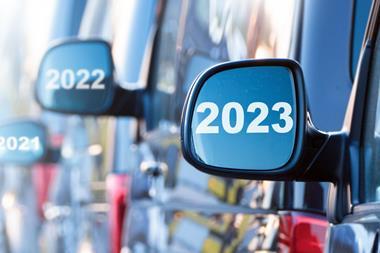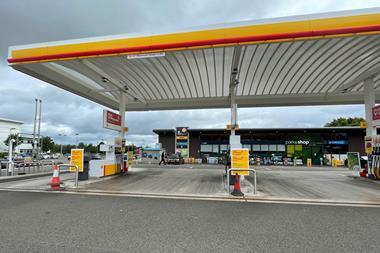There may still be teething problems, but now that the rollout of Chip & PIN is well under way, a seminar last month suggested that it was time for forecourts to fully explore pay-at-pump technology. The question was raised at a ‘Chip & PIN at the Pump’ seminar, organised by payment specialist Trintech. The aim of the event was to bring a number of partners and industry experts together to explore the issues and challenges in deploying Chip & PIN in the forecourt and share their international experiences. The seminar also looked at the latest technology trends and certification requirements. It was attended by more than 40 delegates from across the industry including fuel retailers, pump manufacturers and forecourt system integrators, as well as oil companies and supermarkets such as Shell, Sainsbury, Somerfield and Tesco.
Trintech’s business development director Denis Madden said that as the industry was close to completing its indoor rollout, it should now be beginning to consider potential solutions for its unattended environments: “The timing is right for pay at pump,” he said. “There have been a lot of false starts but we believe widescale adoption of outdoor unattended payment systems is just 12 months behind the indoor Chip & PIN implementation.
“Previous barriers to pay-at-pump adoption have been availability of product and the risk of fraud. Both these issues have been overcome – there are new products that meet all requirements and there’s the introduction of Chip cards to help prevent the use of stolen cards.
“Pay at pump offers many business benefits for fuel retailers including customer convenience and easing of congestion on the forecourt. And the fact that consumers are getting much more used to self-service systems through use of mobile phone top-up kiosks, ATMs and DVD vending machines, is great news.”
Madden kicked off the proceedings with a global overview of the pay-at-pump market, showing penetration internationally. “Pay at pump rollout differs from country to country. According to Datamonitor, the UK currently has less than 10% penetration compared to 100% in the US and Scandinavia. One of the major historical reasons for this has been inadequate card holder and card authentication on the forecourt.”
However, he added, the successful implementation of Chip & PIN had given retailers the confidence to look at the whole issue of unattended payments. Madden then outlined the key success factors for implementation of a pay-at-pump project, outlining the business benefits and the operational impact.
There was particular excitement surrounding the presentation by Stefan Kristensson, payment product manager at Dresser Wayne, as he unveiled the company’s first Chip & PIN pay-at-pump terminal for the UK – the PT 4000-EMV. He declared that payment security would drive fuel retailer investment in the next three to five years. “Key new technologies will include biometrics at the pump – there’s already a project in Portugal with an integrated thumb-print reader. Then there are contactless readers at the pump in the US, which eliminate the need for a mechanical card reader, which is the highest maintenance item in a pay-at-pump terminal.”
Kristensson told delegates that the pump of the future will have remote diagnostics capability; streaming video for dynamic advertising and messaging; and POS that’s fully integrated into the pump head.
An overview of the integration options available to fuel retailers was then provided by Eduard Kunce, development manager of Radiant Systems.
“The world is becoming global – meaning that Radiant’s strategy has moved from point solutions for each project to developing an international pay at the pump solution for all markets. We place a heavy emphasis on a standards-based approach to solutions development, mentioning the key standards as IFSF, IXRETAIL and IXPOS. This gives the retailer a greater degree of redundancy and freedom to change vendors without incurring heavy changeover costs.
“The key decision points that retailers should consider when choosing a pay-at-pump system are: an improved retailing experience for the user; language selection; passive marketing (ads); interactive marketing such as targeted promotions; and transactional marketing (cross-selling).”
Felix Timmerman, business development director at Torex Retail outlined his company’s ‘tank to bank’ philosophy which provides complete control from tanker depot to putting petrol into the car.
Timmerman said he was a strong advocate of the “open systems” approach of adopting recognised industry standards such as IFSF, NAXML, IXRETAIL and ARTS.
“The key win for this approach for the retailer is twofold,” he said. “There’s resilience – having redundant system architectures reduces the cost of maintenance contracts because of the greater uptime of systems; and there’s no vendor lock-in – the idea being that a retailer can choose a solution without fear of being tied into a specific vendor architecture for the lifetime of a project.”
Keith Tobin, development manager at Unattended Payment Terminals, presented details of his company’s complete turnkey solution. He said they provided solutions – not products – that were easy to install, reliable and easy to use. “Certifications are in place for an end-to-end card payment solution that uses a secure GPRS communication between petrol station and a central processing host.”
The final presentation was from Martin Lewis, manager of card payments at APACS. He updated delegates on the progress of Chip & PIN implementation in the UK. Lewis said the next big thing for APACS was the ‘I love PIN’ day on February 14, 2006. “Our aim is to communicate the full benefits of Chip & PIN and particularly the security it offers.
“The point of the ‘I love PIN’ day will be that although a lot of cardholders in the UK are using Chip & PIN, some are still asking retailers if they can sign off the transaction. From February 14 retailers will be asked not to allow consumers to use this fallback option.”
For more information on unattended payment systems go to www.openpaynews.com.





























No comments yet